본 소개 자료는 Elsevier에서 발행한 ["고강도 강 및 다이캐스팅 알루미늄의 셀프 피어싱 리벳팅에 대한 공정 변수 및 열처리 영향"] 논문의 연구 내용입니다.
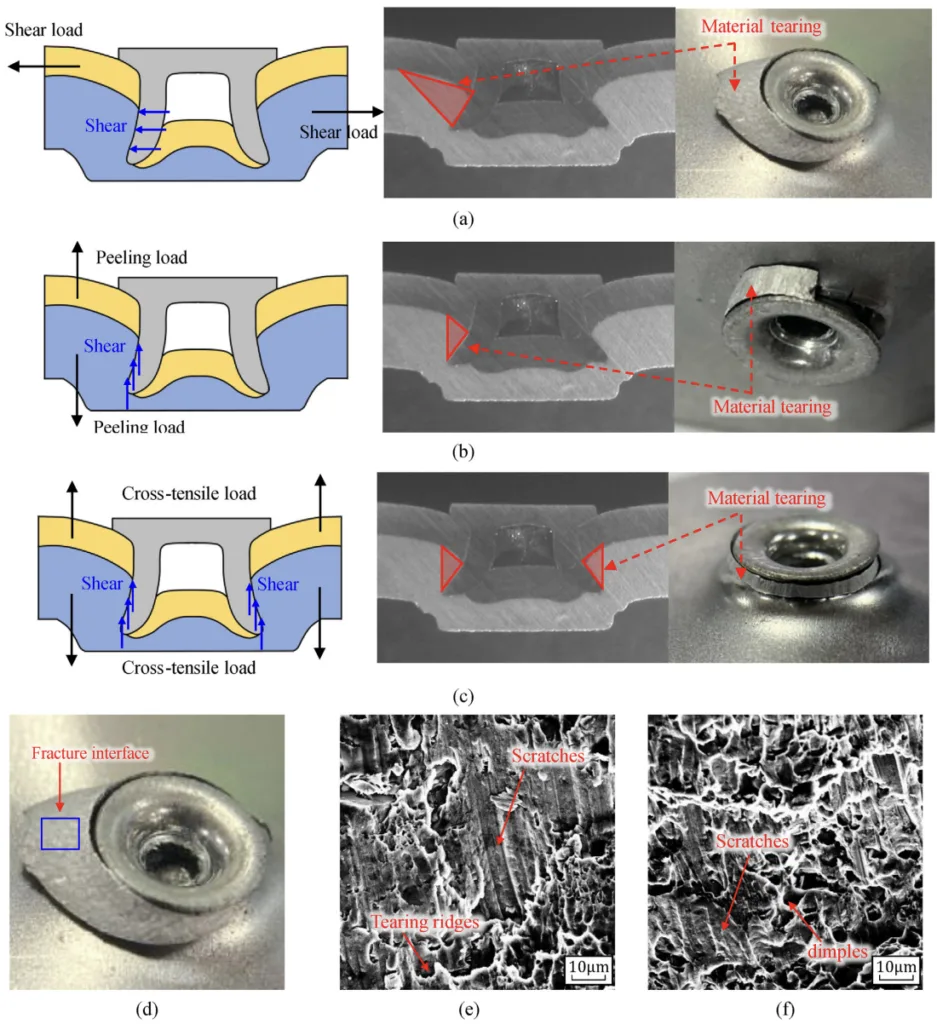
1. 개요:
- 제목: 고강도 강 및 다이캐스팅 알루미늄의 셀프 피어싱 리벳팅에 대한 공정 변수 및 열처리 영향
- 저자: Chao Wang, Zhanpeng Du, Aiguo Cheng, Zhicheng He, Hailun Tan, Wanyuan Yu
- 출판 연도: 2023
- 발표 저널/학회: Journal of Materials Research and Technology
- 키워드: 셀프 피어싱 리벳팅, 다이캐스팅 알루미늄, 크래킹 메커니즘, 접합성, 기계적 반응
2. 초록
자동차 경량화 기술 개발에 있어 강/다이캐스팅 알루미늄 합금의 적용은 필연적인 추세입니다. 셀프 피어싱 리벳팅(SPR)의 접합 공정은 차체의 충돌 안전성을 보장하는 핵심 기술입니다. 그러나 다이캐스팅 알루미늄의 낮은 연성으로 인해 조인트 버튼에 균열이 쉽게 발견될 수 있습니다. 이 논문은 균열 메커니즘을 조사하고 균열 억제 방법을 탐색하여 SPR 접합성을 개선하는 것을 목표로 합니다. 강/다이캐스팅 알루미늄 합금을 사용한 SPR의 균열 억제 및 성형 품질에 대한 열처리, 공정 변수의 영향을 탐색하기 위해 파라메트릭 연구가 수행되었습니다. 연구 결과, 적절한 열처리, 즉 AlSi10MnMg-T6 및 AlSi10MnMg-T7을 통해 더 큰 연신율과 더 낮은 항복 강도로 SPR 접합성을 향상시킬 수 있음을 보여줍니다. 한편, 다이의 깊이와 직경은 균열 생성 및 성형 품질에 영향을 미치는 주요 요인입니다. 업셋팅 공정과 유사하게 리벳팅 공정에서 접선 인장 응력이 하부 표면에 발생하여 하부 표면에 균열이 발생합니다. 이 논문은 SPR 조인트의 조인트 품질 및 기계적 반응에 대한 열처리 및 스택 방향의 영향을 추가로 연구합니다. 하부 시트의 찢김 파손은 강-알루미늄 조인트(강이 상부 시트)의 파손을 유발하는 주요 요인입니다. 열처리는 주로 에너지 흡수 값에 영향을 미치고 피크 힘에는 상대적으로 작은 영향을 미칩니다. 강-알루미늄 조인트의 기계적 특성은 알루미늄-강 조인트(알루미늄이 상부 시트)보다 우수합니다.
3. 연구 배경:
연구 주제 배경:
- 경량화는 자동차 산업에서 에너지 절약 및 배기가스 감소를 달성하기 위한 시급한 요구 사항입니다 [1].
- 차체(BIW)에서 알루미늄과 고강도 강철의 혼합 사용은 경량화를 위한 실용적인 방법입니다 [2,3].
- 다이캐스팅 알루미늄 부품은 차량 무게를 줄일 수 있습니다[2,3].
선행 연구 현황:
- 저항 점용접(RSW)은 강철-알루미늄 시트 접합에 적합하지 않습니다 [4].
- 셀프 피어싱 리벳팅(SPR)은 알루미늄 및 혼합 재료 경량 구조물의 핵심 접합 공정입니다 [5].
- 이전 연구에서는 공정 변수(시트 두께, 리벳 길이, 다이 형상)가 SPR 조인트 품질 및 강도에 미치는 영향을 조사했습니다 [6,7,8,9,10,11,12,13].
- 다이캐스팅 알루미늄 하부 시트의 균열은 내식성 및 조인트 강도에 영향을 미치는 중요한 문제입니다 [14-17].
- 균열을 줄이는 기존 방법에는 공정 변수 최적화, 연성 재료 추가 및 새로운 SPR 공정(F-SPR, L-SPR, TA-SPR)이 포함됩니다 [15,19,20,21,22,23,24,25,26,27,28,29,30,31,32,33,34].
- 열처리는 주조 알루미늄 합금의 기계적 특성에 영향을 줄 수 있습니다 [35,36,37].
연구 필요성:
- 공정 변수와 열처리가 균열 및 성형 품질에 미치는 복합적인 영향에 대한 연구는 제한적입니다.
- 저연성 다이캐스팅 알루미늄에 적합한 다용도 리벳과 다이를 선택하는 방법이 명확하지 않습니다.
- 공정 변수와 열처리의 복합적인 효과에 대한 포괄적인 고려가 부족합니다.
- 열처리 및 비열처리 재료의 영향에 대한 조사가 필요합니다.
4. 연구 목적 및 연구 질문:
연구 목적:
- 강/다이캐스팅 알루미늄의 SPR에서 균열 메커니즘을 조사합니다.
- 균열 억제 방법을 탐색하여 SPR 접합성을 개선합니다.
- 적절한 공정 변수 및 열처리를 사용하여 다이캐스팅 알루미늄 부품의 균열을 해결합니다.
- 기계적 반응에 대한 열처리 및 스택 방향의 영향을 탐색합니다.
핵심 연구:
- 리벳 길이, 다이 직경, 다이 깊이 및 열처리가 조인트 품질에 미치는 영향.
- 현미경을 사용한 균열 생성 메커니즘 분석.
- SPR 조인트의 기계적 반응에 대한 열처리 및 스택 방향의 영향.
5. 연구 방법
- 연구 설계: 파라메트릭 연구, 실험적 조사.
- 재료: 고강도 강철 HC340/590DP(두께 1.6mm), 다이캐스팅 알루미늄 AlSi10MnMg 및 JDA1b(두께 3.0mm). 화학 조성은 표 1에 자세히 설명되어 있습니다. 재료 특성은 표 3에 있습니다.
- 열처리: AlSi10MnMg에 대한 세 가지 열처리 조건(T5, T6, T7)이 사용되었으며 표 2에 나열되어 있습니다.
- 리벳팅 세부 정보: 서보 SPR 시스템(EPRESS GmbH), 하중 제어 모드, 최대 리벳팅 힘 80kN, 리벳팅 속도 100mm/s. 붕소강(H5)으로 만든 반관형 리벳. 다양한 파라미터(표 5, 그림 2)를 가진 세 가지 유형의 다이(플랫 다이 I, 플랫 다이 II, 핍 다이).
- 실험 설정: 알루미늄을 하부 시트로 사용. 표 4의 자세한 분석 체계.
- 데이터 수집:
- 다양한 파라미터(리벳 길이, 다이 직경, 다이 깊이, 열처리)를 사용한 리벳팅 실험.
- 금속 현미경 및 주사 전자 현미경(SEM) 분석.
- 범용 시험기(ETM105D)를 사용한 준정적 시험(전단, 박리, 십자 인장) (3mm/min).
- 분석 방법:
- 조인트 품질 평가: 성형 품질(리벳 헤드 높이, 언더컷, 하부 두께, 잔류 두께 - 그림 3(a), 표 6) 및 외관 품질(균열 등급 - 그림 4).
- 접합성 매트릭스(그림 6).
- 균열 메커니즘 분석.
- 기계적 특성(피크 힘, 에너지 흡수) 비교.
6. 주요 연구 결과:
주요 연구 결과 및 제시된 데이터 분석:
- 접합성: 열처리(AlSi10MnMg-T6, AlSi10MnMg-T7)를 통해 더 큰 연신율과 더 낮은 항복 강도로 SPR 접합성을 개선할 수 있습니다(그림 8).
- 다이 깊이 및 직경: 다이의 깊이와 직경은 균열 생성 및 성형 품질에 큰 영향을 미칩니다(그림 9). 더 큰 깊이와 직경은 성형 품질을 향상시키지만 균열 위험을 증가시킵니다.
- 리벳 길이: 리벳 길이는 균열 생성에 상대적으로 작은 영향을 미칩니다. 적절한 리벳 길이(6.0-6.5mm)는 성형 품질을 향상시킬 수 있습니다.
- 균열 메커니즘: 리벳팅 중 하부 표면에 발생하는 접선 인장 응력은 균열을 유발합니다(그림 11, 그림 12, 그림 13, 그림 14, 그림 15).
- 스택 방향: 강-알루미늄 조인트(강철 상단, 알루미늄 하단)는 알루미늄-강 조인트보다 우수한 기계적 특성을 갖습니다(그림 20).
- 열처리 효과: 열처리는 주로 에너지 흡수에 영향을 미치며 피크 힘에는 더 작은 영향을 미칩니다(그림 20).
- 파손 모드: 하부 시트의 찢김 파손은 강-알루미늄 조인트(강이 상부 시트)의 파손을 유발하는 주요 요인입니다.
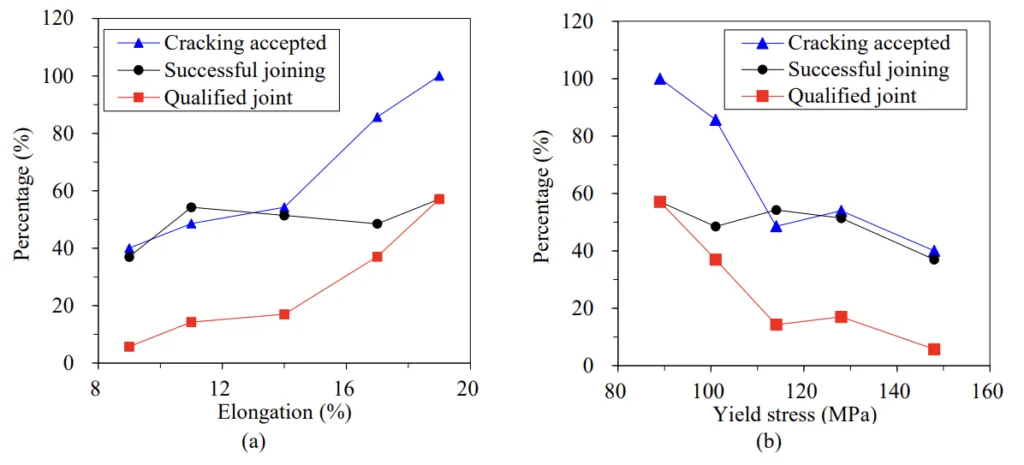
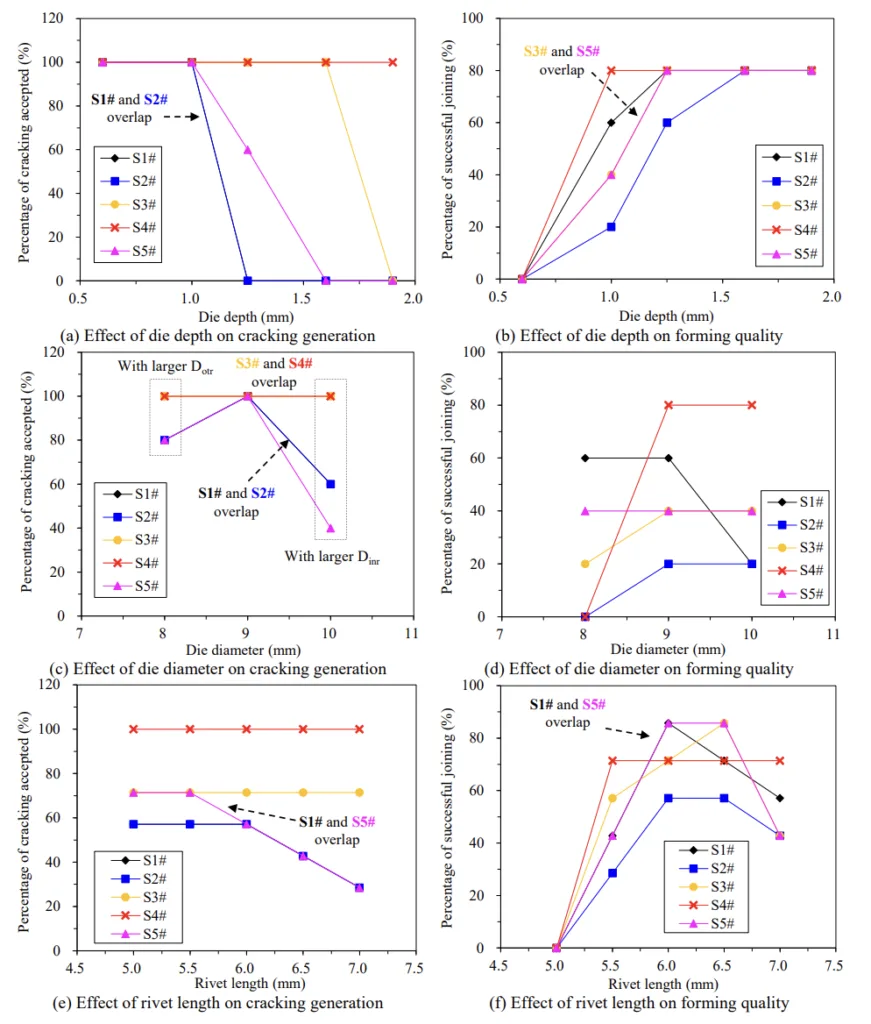
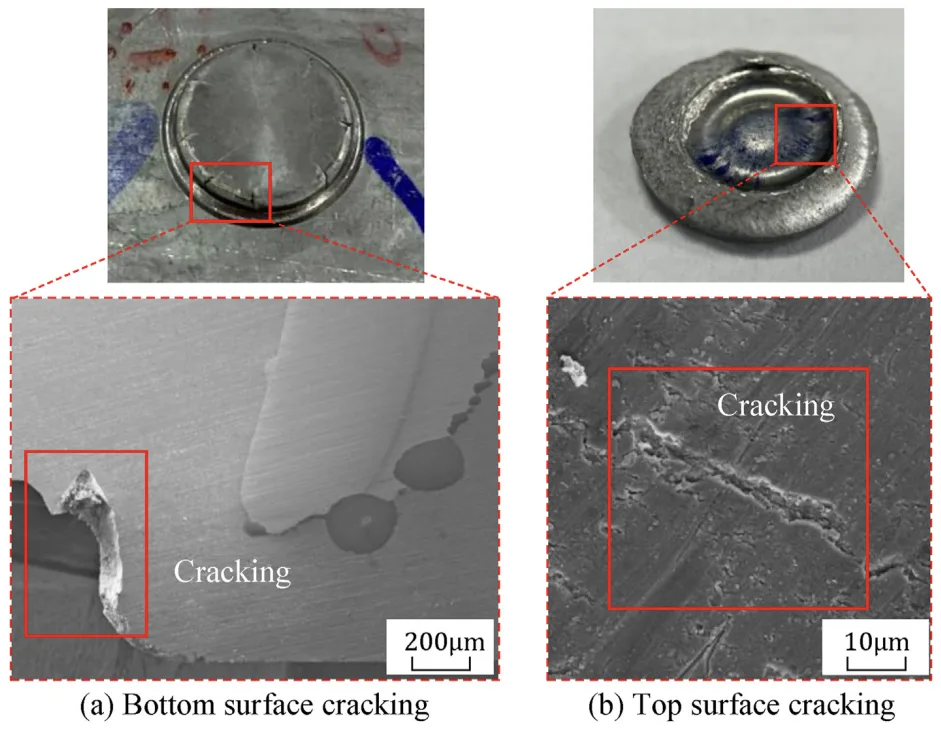
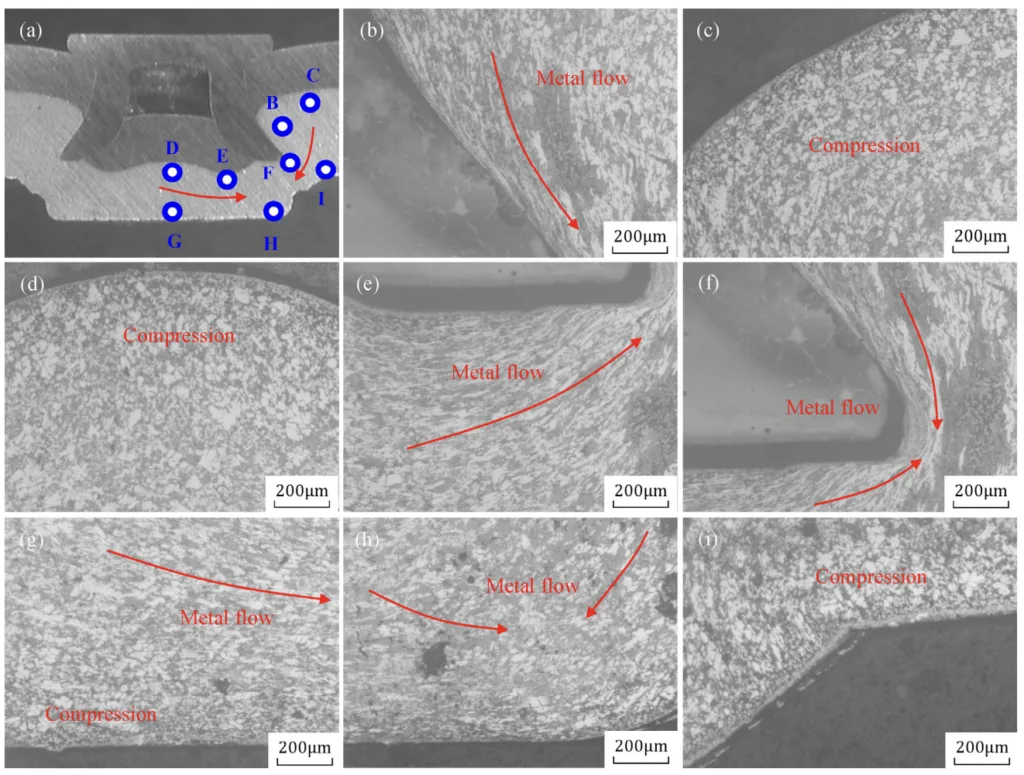

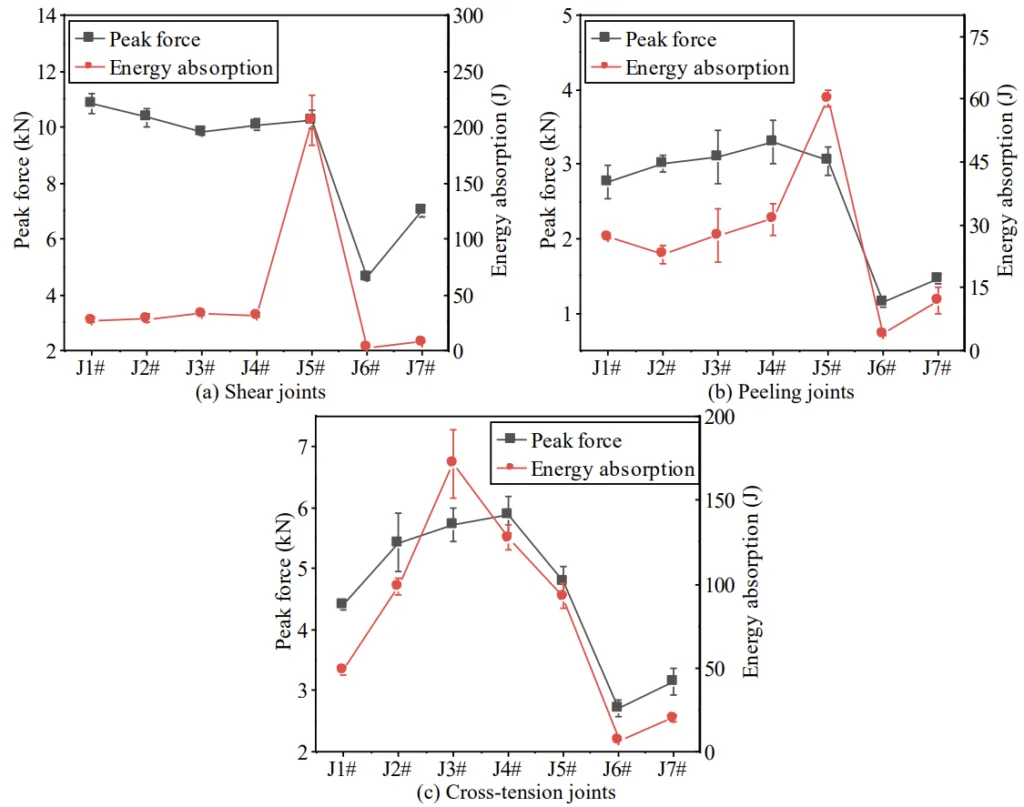
그림 이름 목록:
- 그림 1 셀프 피어싱 리벳팅 장비.
- 그림 2 리벳과 다이의 외관 및 치수 파라미터.
- 그림 3 성형 품질의 개략도.
- 그림 4 외관 품질의 개략도.
- 그림 5 SPR 조인트 및 준정적 시험의 기하학적 치수.
- 그림 6 다양한 리벳과 다이 조합의 조인트 품질.
- 그림 7 S4#의 SPR 조인트의 중앙 횡단면 프로파일.
- 그림 8 다양한 연신율 및 항복 강도의 조인트 품질.
- 그림 9 리벳과 다이의 파라미터가 조인트 품질에 미치는 영향.
- 그림 10 다이의 치수 파라미터 선택: (a) 깊이 및 (b) 직경.
- 그림 11 하부 시트의 두 가지 유형의 균열 특성.
- 그림 12 변형 정도에 따른 세 영역.
- 그림 13 SPR 조인트의 횡단면 금속 조직 사진.
- 그림 14 세 가지 유형의 다이의 균열 특성.
- 그림 15 하부 표면 균열의 개략도: (a) 피어싱 (b) 플레어링, (c) 위험 영역 및 안전 영역.
- 그림 16 SPR 조인트의 횡단면 프로파일, 외관 품질 및 성형 품질(단위: mm).
- 그림 17 준정적 시험에서 SPR 조인트의 정적 파손 모드.
- 그림 18 파손 메커니즘 및 조인트의 미세 형태: (a) 전단 조인트, (b) 박리 조인트, (c) 십자 인장 조인트, (d) 거시적 파단, (e) 조인트 J2#의 확대도, (f) 조인트 J4#의 확대도.
- 그림 19 십자 인장 시험의 하부 시트 파단: (a) 거시적 파단, (b) 조인트 J1#의 확대 영역, (c) 조인트 J2#의 확대 영역, (d) 조인트 J5#의 확대 영역.
- 그림 20 다양한 열처리 및 스택 방향을 사용한 SPR 조인트의 기계적 특성.
7. 결론:
주요 결과 요약:
- 열처리를 통해 더 큰 연신율과 더 낮은 항복 강도로 SPR 접합성이 향상됩니다.
- 다이 깊이와 직경은 균열 및 성형 품질에 영향을 미치는 주요 요인입니다.
- 균열은 하부 표면의 접선 인장 응력에 의해 발생합니다.
- 강-알루미늄 조인트는 알루미늄-강 조인트보다 기계적 특성이 우수합니다.
- 열처리는 주로 에너지 흡수에 영향을 미치며 피크 힘에는 영향을 미치지 않습니다.
- 하부 시트의 찢김 파손은 강-알루미늄 조인트(강이 상부 시트)의 파손을 유발하는 주요 요인입니다.
이 연구는 강/다이캐스팅 알루미늄 조인트의 SPR에서 균열 메커니즘에 대한 자세한 이해를 제공합니다.
접합성을 개선하고 균열을 방지하기 위해 적절한 공정 변수 및 열처리를 선택하기 위한 실질적인 지침을 제공합니다.
이 연구 결과는 강철과 다이캐스팅 알루미늄의 안정적인 접합을 가능하게 하여 경량 자동차 제조 발전에 기여합니다.
8. 참고 문헌:
- [1] Duan LB, Xiao NC, Hu ZH, Li GY, Cheng AG. An efficient lightweight design strategy for body-in-white based on implicit parameterization technique. Struct Multidiscip O 2016;55:1927–43.
- [2] Niu ZC, Liu GY, Li T, Ji SX. Effect of high pressure die casting on the castability, defects and mechanical properties of aluminium alloys in extra-large thin-wall castings. J Mater Process Technol 2022;303:117525.
- [3] Lou M, Li YB, Wang Y, Wang B, Lai XM. Influence of resistance heating on self-piercing riveted dissimilar joints of AA6061-T6 and galvanized DP590. J Mater Process Technol 2014;214:2119–26.
- [4] Li DZ, Chrysanthou A, Patel I, Williams G. Self-piercing riveting-a review. Int J Adv Manuf Technol 2017;92:1777–824.
- [5] Sun X, Khaleel M. Performance optimization of self-piercing rivets through analytical rivet strength estimation. J Manuf Process 2005;7:83–93.
- [6] Zhao H, Han L, Liu YP, Liu XP. Quality prediction and rivet/die selection for SPR joints with artificial neural network and genetic algorithm. J Manuf Process 2021;66:574–94.
- [7] Wang DF, Kong DW, Xie C, Li SH, Zong L. Study on the effect of rivet die parameters on joint quality of self-piercing riveting employed 3D modeling and MCDM method. Int J Adv Manuf Technol 2022;119:8227–41.
- [8] Zhao H, Han L, Liu YP, Liu XP. Analysis of joint formation mechanisms for self-piercing riveting (SPR) process with varying joining parameters. J Manuf Process 2022;73:668–85.
- [9] Karathanasopoulos N, Pandya KS, Mohr D. An experimental and numerical investigation of the role of rivet and die design on the self-piercing riveting joint characteristics of aluminum and steel sheets. J Manuf Process 2021;69:290–302.
- [10] Liu YP, Li H, Zhao H, Liu XP. Effects of the die parameters on the self-piercing riveting process. Int J Adv Manuf Technol 2019;105:3353–68.
- [11] Du ZP, Duan LB, Jing LJ, Cheng AG, He ZC. Numerical simulation and parametric study on self-piercing riveting process of aluminium-steel hybrid sheets. Thin-Walled Struct 2021;164:107872.
- [12] Du ZP, Wei BL, He ZC, Cheng AG, Duan LB, Zhang G. Experimental and numerical investigations of aluminium- steel self-piercing riveted joints under quasi-static and dynamic loadings. Thin-Walled Struct 2021;169:108277.
- [13] Zhang XL, He XC, Xing BY, Wei WJ, Lu JW. Quasi-static and fatigue characteristics of self-piercing riveted joints in dissimilar aluminium-lithium alloy and titanium sheets. J Mater Res Technol 2020;9:5699–711.
- [14] Wang XY, Fang YD, Zhan ZF. A crack detection and evaluation method for self-piercing riveting. IMECE 2018;52170:V012T11A06.
- [15] Jäckel M, Grimm T, Niegsch R, Drossel W. Overview of current challenges in self-pierce riveting of lightweight materials. ICEM 2018;2:384–9.
- [16] Hu K, Jiang L, Zhan ZF, Wu F. Crack detection and evaluation method for self-piercing riveting button images based on BP neural network. IMECE 2021;85581:V004T04A21.
- [17] Ang HQ. An overview of self-piercing riveting process with focus on joint failures, corrosion issues and optimisation techniques. Chin J Mech Eng-En 2021;34:1–25.
- [18] Zhao XZ. Research on applying the self-pierce riveting (SPR) for die casting aluminum alloys. Purdue University; 2019. Dr.
- [19] Li DZ, Han L, Lu ZJ, Thornton M, Shergold M. Influence of die profiles and cracks on joint buttons on the joint quality and mechanical strengths of high strength aluminium alloy joint. Adv Mater Res 2012;548:398–405.
- [20] Jäckel M, Coppieters S, Hofmann M, Vandermeiren N, Landgrebe D. Mechanical joining of materials with limited ductility: analysis of process-induced defects. AIP Conf Proc 2017;1896:110009.
- [21] Neuser M, Kappe F, Busch M, Grydin O, Bobbert M. Joining suitability of cast aluminium for self-piercing riveting. IOP Conf Ser Mater Sci Eng 2021;1157:012005.
- [22] Neuser M, Kappe F, Ostermeier J, Krüger JT, Bobbert M. Mechanical properties and joinability of AlSi9 alloy manufactured by twin-roll casting. Adv Eng Mater 2022;24:2200874.
- [23] Liu YC, Wang G, Weiler J. Joining magnesium die casting using self-piercing riveting with a rivet receiver. SAE Techni Paper 2021:2021010275.
- [24] Drossel WG, Jaeckel M. New die concept for self-pierce riveting materials with limited ductility. Key Eng Mater 2014;611–612:1452–9.
- [25] Yang BX, Ma YW, Shan H, Niu SZ, Li YB. Friction self-piercing riveting (F-SPR) of aluminum alloy to magnesium alloy using a flat die. J Magnesium Alloys 2021;10:1207–19.
- [26] Li YB, Wei ZY, Wang ZZ, Li YT. Friction self-piercing riveting of aluminum alloy AA6061-T6 to magnesium alloy AZ31B. J Manuf Sci E-T Asme 2013;135:061007.
- [27] Ma YW, Yang BX, Hu SQ, Shan H, Geng Ph, Li YB, et al. Combined strengthening mechanism of solid-state bonding and mechanical interlocking in friction self-piercing riveted AA7075-T6 aluminum alloy joints. J Mater Sci Technol 2022;105:109–21.
- [28] Han SL, Li ZY, Wang ZY, Li Y. Review on joining processes of magnesium alloy sheets. Int J Adv Manuf Technol 2022;118:2787–803.
- [29] Ma YW, He GZ, Lou M, Li YB, Lin ZQ. Effects of process parameters on crack inhibition and mechanical interlocking in friction self-piercing riveting of aluminum alloy and magnesium alloy. J Manuf Sci E-T Asme 2018;140:101015.
- [30] Durandet Y, Deam R, Beer A, Song W, Blacket S. Laser assisted self-pierce riveting of AZ31 magnesium alloy strips. Mater Des 2010;31:S13–6.
- [31] Deng L, Lou M, Li YB, Carlson BE. Thermally assisted self- piercing riveting of aluminum AA6061-T6 to ultra-high strength steels. Inter Manuf Sci Eng Conf 2018;51364:V002T04A36.
- [32] Yang BX, Ma YW, Shan H, Li YB. A comparative study of self- piercing riveting and friction self-piercing riveting of cast aluminum alloy Al-Si7Mg. J Manuf Sci E 2023;145:0011003.
- [33] Klein T, Kirov G, Ucsnik S. Self-piercing riveting of medium- and high-strength Al and Mg alloy sheets enabled by in- process electric resistance heating. J Manuf Sci E-T Asme 2021;143:034502.
- [34] Deng L, Lou M, Li YB, Carlson BE. Thermally assisted self- piercing riveting of AA6061-T6 to ultrahigh strength steel. J Manuf Sci E-T Asme 2019;141:101006.
- [35] Mallick PK. Materials, design and manufacturing for lightweight vehicles. Woodhead publishing; 2020.
- [36] Zhao X, Meng D, Zhang JY, Han QY. The effect of heat treatment on die casting aluminum to apply self-pierce riveting. Int J Adv Manuf Technol 2020;109:2409–19.
- [37] Yarcu S, Huebner S, Yilkiran D, Brunotte K, Behrens BA, Schuchardt T, et al. Clinching of heated aluminum die casting. Congr Ger Acad Assoc Prod Tech 2021:85–93.
- [38] Haque R. Quality of self-piercing riveting (SPR) joints from cross-sectional perspective: a review. Arch Civ Mech Eng 2018;18:83–93.
- [39] Xie ZQ, Yan WM, Yu C, Mu TT, Song LL. Improved shear strength design of cold-formed steel connection with single self-piercing rivet. Thin-Walled Struct 2018;131:708–17.
- [40] Li DZ, Han L, Chrysanthou A, Shergold M, Williams G. The effect of setting velocity on the static and fatigue strengths of self-piercing riveted joints for automotive applications. TMS Annual Conference 2014:557–64.
- [41] Han L, Thornton M, Li DZ, Shergold M. Effect of setting velocity on self-piercing riveting process and joint behaviour for automotive applications. SAE Technical Paper 2010. 2010-01-0966.
- [42] Zhao H, Han L, Liu YP, Liu XP. Modelling and interaction analysis of the self-pierce riveting process using regression analysis and FEA. Int J Adv Manuf Technol 2021;113:159–76.
- [43] Ma YW, Lou M, Li YB, Lin ZQ. Effect of rivet and die on self- piercing rivetability of AA6061-T6 and mild steel CR4 of different gauges. J Mater Process Technol 2018;251:282–94.
- [44] Kajtoch J. Strain in the upsetting process. Metall Foundry Eng 2007;33:51–61.
- [45] Sahin M, Cetinarslan CS, Akata HE. Effect of surface roughness on friction coefficients during upsetting processes for different materials. Mater Des 2007;28:633–40.
- [46] Lin SY. An investigation of die-workpiece interface friction during the upsetting process. J Mater Process Technol 1995;54:239–48.
- [47] Lin YC, Chen MS. Numerical simulation and experimental verification of microstructure evolution in a three- dimensional hot upsetting process. J Mater Process Technol 2009;209:4578–83.
- [48] Lin YC, Chen MS, Zhong J. Numerical simulation for stress/ strain distribution and microstructural evolution in 42CrMo steel during hot upsetting process. Comput Mater Sci 2008;43:1117–22.
- [49] Kim C, Min KM, Choi H, Kim HJ, Lee MG. Development of analytical strength estimator for self-piercing rivet joints through observation of finite element simulations. Int J Mech Sci 2021;202:106499.
- [50] Huang ZC, Zhou ZJ, Jiang YQ. Effect of shot peening on static and fatigue properties of self-piercing riveting joints. J Mater Res Technol 2022;18:1070–80.
9. 저작권:
- 본 자료는 "Chao Wang, Zhanpeng Du, Aiguo Cheng, Zhicheng He, Hailun Tan, Wanyuan Yu"의 "고강도 강 및 다이캐스팅 알루미늄의 셀프 피어싱 리벳팅에 대한 공정 변수 및 열처리 영향" 논문을 기반으로 합니다.
- 논문 출처: https://doi.org/10.1016/j.jmrt.2023.09.187
본 자료는 위 논문을 소개하기 위해 작성되었으며, 상업적 목적으로 무단 사용을 금합니다. Copyright © 2025 CASTMAN. All rights reserved.